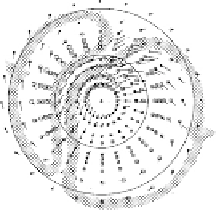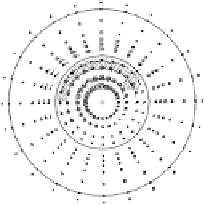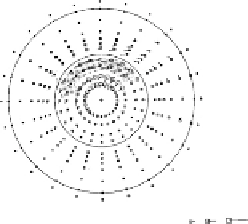Geoscience Reference
In-Depth Information
B
z
South
12
12
60
8
60
8
06
1
1
18
Total
Total
®
23.5
B
y
½
B
z
½
.1.8
B
y
®
3.5
½
B
z
½
.
1.8
60
8
60
8
1
06
2
18
Residual
Residual
B
y
®
2
3.5
B
y
®
3.5
50
100 200 nT
00
00
½
B
z
½
.
1.8
½
B
z
½
.
1.8
Figure 8.29
The arrows indicate the flow direction of horizontal currents in the high-
latitude ionosphere. In the top two diagrams the total currents are indicated. Features
of these currents that are present for any orientation of the IMF have been removed
in the lower two diagrams, which therefore represent IMF-dependent horizontal cur-
rents. [After Friis-Christensen (1981). Reproduced with permission of Reidel, Hingham,
Massachusetts.]
meridian. This “DPY current” flows from dawn to dusk when
B
y
is positive and
from dusk to dawn when
B
y
is negative. The DPY current produces a rotation
and an asymmetry in the current vortices so that the high-latitude sunward-
flowing current is directed toward the prenoon sector for both polarities of the
IMF. When the
z
component of the IMF is very small the two-cell horizontal
current system is preserved, but the intensity of the current is much less than
that existing when the IMF is strongly southward. As
B
y
changes from negative
to positive, the line of symmetry for the current vortices rotates clockwise as it
does for a southward IMF. However, when
B
z
is very small the degree of rotation
is much larger, leading to currents that flow almost parallel to the dawn-dusk
meridian when
B
y
is positive.




















Search WWH ::

Custom Search